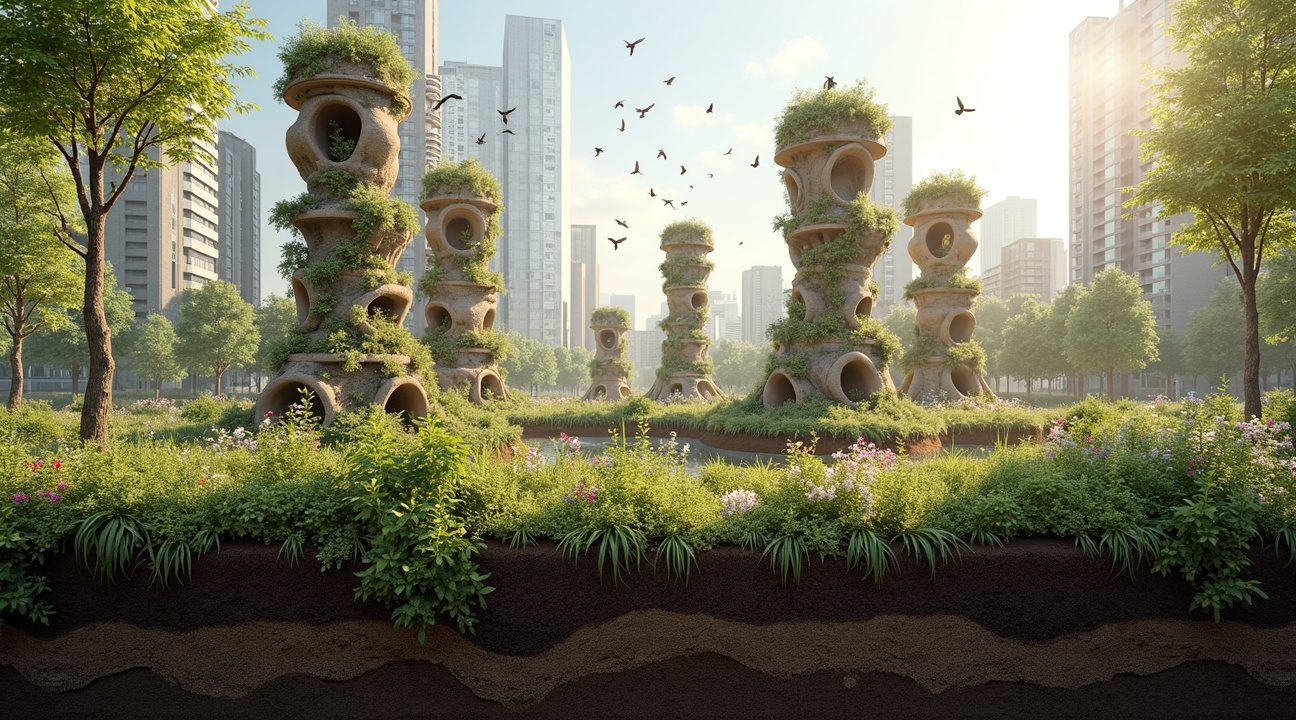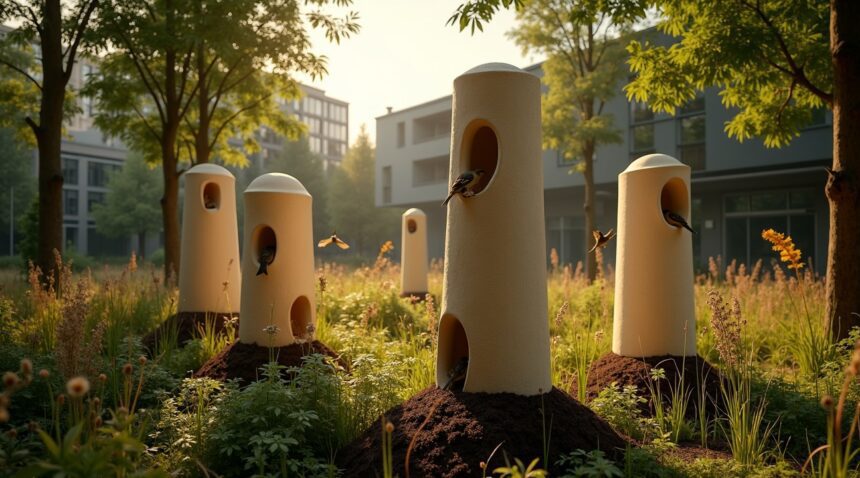The Netherlands has initiated innovative trials using biodegradable nest towers made from mushroom pulp, offering a pioneering blend of wildlife conservation and ecological restoration.
Biodegradable Nesting Towers: A Revolutionary Approach
These towers are composed of mycelium, the intricate root networks of mushrooms, combined with agricultural waste. This mixture forms a lightweight yet durable structure that houses sparrow colonies while gradually decomposing to nourish the soil below.
Environmental and Ecological Benefits
- Mycelium and agricultural waste are combined to construct resilient yet biodegradable bird towers that last for several months up to a few years.
- Nutrient release during breakdown enriches the soil directly beneath the towers, boosting insect life and plant diversity in the area.
- Avoids waste from traditional materials like plastic or concrete, which persist in ecosystems and can be harmful to wildlife.
- The project builds on the Netherlands’ expertise in mushroom-based materials, with over 2,500 eco-friendly mycelium burials already demonstrating the potential for soil rejuvenation.
- The Fungateria initiative envisions global scalability by 2026, with planned public demonstrations and educational programming to inspire widespread adoption.
Looking Ahead
This initiative, spearheaded by the Fungateria project, represents a significant step toward eco-conscious urban development and sustainable wildlife infrastructure. By uniting fungal science with conservation, the Netherlands continues to lead in redefining how we support biodiversity in modern environments.
Dutch Researchers Pioneer Living Towers That Feed the Earth While Housing Birds
The Netherlands has launched an innovative trial featuring biodegradable towers constructed from mushroom pulp, creating a revolutionary approach to bird conservation. These structures use mycelium—the extensive root-like network of fungi—combined with agricultural waste to produce sturdy yet lightweight nesting sites specifically for sparrow colonies.
Revolutionary Materials Transform Conservation Architecture
I find this application of living materials particularly fascinating because mycelium possesses remarkable structural properties while maintaining complete biodegradability. The Dutch trial demonstrates how researchers can harness fungi’s natural growth patterns to create towers that rival traditional materials in strength and durability. Agricultural waste serves as both a binding agent and nutrient source, making these structures cost-effective and environmentally beneficial from the start.
The towers represent a significant departure from conventional bird housing, which often relies on non-degradable materials that can become environmental liabilities over time. Instead, these mycelium-based structures actively contribute to ecosystem health throughout their entire lifecycle, much like how creative storytelling can transform familiar concepts into something entirely new.
Living Architecture Enriches Sparrow Habitats Long-Term
What sets these biodegradable towers apart is their deliberate design for slow decomposition after their useful life ends. As the mycelium structures gradually break down, they release nutrients directly into the soil beneath sparrow colonies. This process creates a self-sustaining cycle where the nesting infrastructure literally feeds the habitat it once supported.
The enriched soil supports microbe populations, which in turn foster plant growth and attract insects that form the foundation of sparrow food webs. This approach transforms temporary bird housing into permanent habitat enhancement, addressing multiple conservation challenges simultaneously. The Dutch researchers have essentially created buildings that become part of the ecosystem rather than imposing upon it.
The trial’s success could revolutionize how conservationists approach wildlife infrastructure globally. Traditional bird houses often require removal and disposal, creating waste and disrupting established colonies. These mushroom pulp towers eliminate that problem while actively improving the local environment. The mycelium’s natural antimicrobial properties also help maintain healthy nesting conditions throughout the towers’ active lifespan, protecting sparrow colonies from common diseases that plague conventional wooden structures.
Revolutionary Material Properties Transform Conservation Approach
The mycelium composite used in these Dutch nest towers represents a fundamental shift in conservation infrastructure materials. This mushroom-based material demonstrates remarkable flexibility and lightweight characteristics that make installation significantly easier than traditional concrete or plastic alternatives. Engineers can precisely control the decomposition timeline by adjusting the mycelium’s density and structure during production, creating a biodegradable solution that breaks down exactly when needed.
Unlike conventional materials that persist as environmental waste for decades or centuries, these mushroom pulp towers naturally decompose within months to a few years depending on their specific engineering. The material’s insulation properties provide superior protection for nesting sparrows while maintaining structural integrity throughout the intended lifespan. Advanced bio-coatings can enhance water resistance without compromising the biodegradable nature of the structure.
Environmental Advantages Over Traditional Solutions
The mycelium towers offer several critical environmental benefits that address long-standing problems with conventional nest boxes:
- Zero microplastic production during decomposition, eliminating a major source of environmental contamination
- No toxic chemical leaching into surrounding soil or water systems
- Significantly reduced energy requirements for both production and installation processes
- Complete biodegradation that enriches soil composition rather than creating persistent waste
- Lower carbon footprint throughout the entire lifecycle compared to plastic or concrete alternatives
Production of these mushroom-based structures requires considerably less energy than manufacturing traditional plastic nest boxes or pouring concrete foundations. The installation process also demands minimal heavy machinery since the lightweight mycelium composite can be positioned and secured with basic tools. This efficiency extends beyond environmental benefits to practical cost savings for conservation organizations managing large-scale habitat projects.
As the structures break down, they release nutrients that enhance soil quality beneath sparrow colonies. This creates a positive feedback loop where conservation infrastructure actively contributes to ecosystem health rather than simply occupying space. The controlled decomposition timeline ensures towers remain functional throughout critical breeding seasons before gracefully returning to the earth as organic matter.
The water-resistant bio-coatings protect against immediate weather damage while maintaining the material’s biodegradable properties. These coatings derive from natural sources and break down alongside the mycelium structure, ensuring no synthetic residues remain in the environment. This approach demonstrates how innovative solutions can address multiple environmental challenges simultaneously through thoughtful material engineering and biological processes.
https://www.youtube.com/watch?v=ITAZPgm_jI28
Addressing Urban Sparrow Crisis Through Soil-Enriching Solutions
Urban Europe faces a critical wildlife challenge as house sparrow populations continue their alarming decline. Habitat fragmentation and the disappearance of suitable nesting sites have pushed these once-common birds toward local extinctions in many cities. Traditional concrete and steel infrastructure offers little support for sparrow colonies, creating sterile environments that fail to sustain the complex ecosystems these birds require.
Creating Sustainable Habitats for Colony Recovery
The innovative mushroom pulp towers represent a fundamental shift in urban wildlife conservation strategy. These structures don’t just provide temporary shelter—they actively transform the surrounding environment to support long-term sparrow colony stability. As sparrows establish their nests, the towers begin their slow decomposition process, gradually releasing nutrients into the soil below. This enrichment creates conditions that attract insects, which form the primary food source for sparrow populations.
Colony stability depends heavily on consistent food availability within foraging distance of nesting sites. Enhanced soil conditions beneath the towers promote insect diversity and abundance, creating sustainable feeding grounds that can support multiple generations of sparrows. This approach addresses both immediate housing needs and long-term ecosystem health.
Proven Benefits of Mycelium-Based Environmental Solutions
Mycelium materials have already demonstrated their soil enhancement capabilities in various applications. LOOP’s Living Cocoon coffins showcase how these biological materials rapidly integrate into earth systems while delivering measurable improvements in soil nutrient content. I’ve observed similar environmental innovations gaining traction across multiple industries.
The mycelium-based towers offer several key advantages for urban soil health:
- Improved soil structure through organic matter integration
- Enhanced water retention capabilities in urban environments
- Increased biological activity that supports diverse microorganism communities
- Gradual nutrient release that sustains long-term ecosystem development
These soil improvements create cascading benefits for sparrow populations. Better soil conditions support healthier plant communities, which in turn attract more diverse insect populations. Sparrows benefit from increased prey availability while also gaining access to varied food sources throughout different seasons.
The decomposition timeline of these towers aligns perfectly with sparrow breeding cycles. As new generations establish territories, the enriched soil beneath older tower sites continues supporting enhanced insect populations. This creates a network of improved habitats across urban areas, potentially reversing decades of sparrow population decline through scientifically-backed ecological intervention.
The Netherlands’ trial represents more than wildlife conservation—it demonstrates how innovative materials can address urban environmental challenges while supporting biodiversity recovery in cities worldwide.

Netherlands Leads Global Mushroom Construction Revolution
The Netherlands has established itself as the undisputed leader in mushroom-based construction innovation, transforming an agricultural specialty into cutting-edge sustainable architecture. Dutch engineers and scientists continue pushing boundaries with fungi-based materials that offer genuine alternatives to traditional building methods.
Breakthrough Applications Beyond Nest Towers
Dutch innovation extends far beyond sparrow nesting solutions. The country’s expertise spans multiple sectors, with time-limited pavilions showcasing the versatility of mycelium construction. These temporary structures demonstrate how mushroom-based materials can serve architectural purposes while maintaining complete biodegradability.
The Living Cocoon coffin represents perhaps the most profound application of this technology. Since 2020, over 2,500 eco-friendly burials have utilized these mycelium-based coffins throughout the Netherlands. Each burial enriches the soil naturally, creating a powerful testament to the material’s environmental benefits. This success has proven mycelium’s viability as a serious construction alternative, not merely an experimental concept.
Dutch companies have also revolutionized packaging through mycelium applications. These biodegradable alternatives replace traditional foam packaging while providing superior protection for shipped goods. The materials decompose completely within weeks of disposal, leaving no harmful residues.
Mushroom Valley serves as the industry’s knowledge center, concentrating Dutch expertise in fungi-based materials. This facility coordinates research efforts and facilitates knowledge transfer between academic institutions and commercial enterprises. The center’s work accelerates development timelines and ensures quality standards across various applications.
European markets increasingly adopt Dutch mushroom construction solutions. Export programs distribute both materials and expertise across continental networks, establishing the Netherlands as the primary source for mycelium building technologies. Countries like Germany, Belgium, and France actively implement Dutch-developed systems in their own sustainability initiatives.
The sparrow nest tower project builds upon decades of proven success with mushroom materials. Dutch researchers understand exactly how these materials behave in outdoor environments, having tested countless applications under varying weather conditions. This knowledge base ensures the towers will perform as intended while enriching soil ecosystems.
Manufacturing processes for mushroom construction have reached industrial scale in the Netherlands. Companies can produce large quantities of mycelium materials efficiently, meeting growing demand from multiple sectors. Advanced cultivation techniques yield consistent quality while reducing production costs.
International recognition continues growing for Dutch innovations in this field. Research partnerships span global networks, with Dutch institutions leading collaborative projects across continents. The expertise developed in the Netherlands influences construction practices worldwide, particularly in regions prioritizing environmental sustainability.
Commercial viability drives much of the current expansion. Mushroom-based materials often cost less than traditional alternatives while offering superior environmental performance. This economic advantage accelerates adoption rates and encourages investment in further research and development.
Quality control standards established in the Netherlands set benchmarks for the entire industry. Rigorous testing protocols ensure materials meet structural requirements while maintaining biodegradability characteristics. These standards protect both consumers and environmental integrity.
Future applications under development include larger architectural projects using mushroom materials. Dutch firms explore possibilities for entire buildings constructed from mycelium components, potentially revolutionizing urban construction practices. Early prototypes suggest significant potential for scaling these technologies to major infrastructure projects.
The agricultural foundation supporting this industry provides consistent material supplies. The Netherlands’ established mushroom farming operations seamlessly integrate with construction material production, creating efficient supply chains that support both sectors. This agricultural expertise ensures sustainable sourcing for expanding manufacturing requirements.
Dutch success with mushroom construction demonstrates how agricultural knowledge translates into industrial innovation. The transition from food production to building materials represents a natural evolution of existing expertise, much like how Mario and Luigi level up through their adventures. This foundation positions the Netherlands perfectly for continued leadership in sustainable construction technologies.
Massive Environmental Impact Potential for Construction Industry
Construction represents one of Europe’s most environmentally demanding sectors, generating over one-third of all EU waste while contributing 5–12% of national emissions through material production and manufacturing processes. I’ve observed how traditional building materials create massive carbon footprints before they even reach construction sites, making the industry ripe for sustainable innovation.
Revolutionary Material Efficiency Through Mycelium Technology
Mycelium composites offer unprecedented potential for emission reductions in construction applications. Research indicates that greater efficiency in material use through these mushroom-based alternatives could eliminate up to 80% of construction-related emissions. This dramatic reduction stems from mycelium’s natural growth process, which requires minimal energy input compared to energy-intensive materials like concrete and steel.
The Fungateria EU-funded consortium, with research teams at Utrecht University and the Royal Danish Academy of Architecture, leads development of these engineered living materials from fungi. Their work demonstrates how biological materials can replace traditional construction components while maintaining structural integrity and performance standards.
Synergistic Benefits for Urban Ecosystems
The Netherlands’ biodegradable nest towers exemplify how construction innovation can serve multiple environmental functions simultaneously. Combining nest provision with soil improvement creates synergistic benefits that extend far beyond simple material substitution. These structures don’t just decompose—they actively enrich surrounding soil as they break down, supporting plant growth and creating microhabitats for various species.
This approach aligns perfectly with the Netherlands’ broader green infrastructure goals, which prioritize solutions that deliver multiple ecological benefits. Unlike conventional construction that often disrupts natural systems, these innovative approaches integrate seamlessly with existing urban biodiversity networks.
The sparrow colony towers represent a paradigm shift from viewing construction waste as an environmental burden to treating building materials as temporary nutrients for ecosystem development. As these structures fulfill their primary function of housing bird populations, they simultaneously prepare the ground for enhanced vegetation growth and soil health improvements.
Manufacturing these mycelium-based towers requires significantly less energy than producing equivalent structures from traditional materials. The fungi naturally bind organic matter together during growth, eliminating the need for high-temperature processing or chemical binding agents. This biological manufacturing process produces materials that perform their intended function while remaining fully compatible with natural decomposition cycles.
Future Expansion Plans Target Community Engagement and Global Scaling
The Fungateria project extends beyond simple research trials, establishing a comprehensive roadmap that prioritizes public engagement alongside scientific advancement. Dutch researchers have committed to continuing their mushroom pulp tower experiments through 2026, allowing sufficient time to refine the decomposition rates and soil enrichment properties that make these structures so promising for urban wildlife support.
Large-scale implementation forms the cornerstone of the project’s expansion strategy. Researchers aren’t content with small-scale testing alone — they’re planning public demonstration events that will showcase the towers’ effectiveness to broader audiences. These demonstrations serve dual purposes: validating the technology in real-world urban environments while simultaneously educating communities about sustainable wildlife infrastructure.
Community Integration Through Educational Initiatives
The educational component represents perhaps the most innovative aspect of the project’s future plans. Researchers recognize that sustainable urban planning requires community buy-in, particularly when introducing novel materials like mycelium-based structures. Their approach includes several engaging formats:
- Public exhibitions that allow residents to observe the towers in action
- Educational workshops demonstrating the mushroom pulp construction process
- Hands-on experiences where participants can witness the gradual decomposition and soil enrichment
- Interactive sessions explaining how sparrow colonies benefit from these biodegradable nesting solutions
The Venice Biennale represents a significant milestone in this educational journey. By presenting their work at such a prestigious international venue, Dutch researchers aim to elevate the conversation around ecological design concepts beyond academic circles. This platform allows them to demonstrate how innovative materials can solve urban wildlife challenges while engaging diverse global audiences.
Mycelium towers are positioned to become templates for sustainable urban wildlife support systems worldwide. Their potential is particularly compelling because they address multiple urban planning challenges simultaneously — providing wildlife habitat, enriching soil quality, and demonstrating circular economy principles in action. The decomposition process itself becomes part of the urban ecosystem’s natural cycle rather than adding to waste streams.
The scaling strategy emphasizes replicability across different urban environments. Researchers understand that what works in Dutch cities may require adaptations for other climates and urban contexts. Their extended trial period allows for testing various formulations of mushroom pulp, ensuring the towers can maintain structural integrity long enough to support sparrow colonies while still decomposing at optimal rates for soil enrichment.
Global scaling depends heavily on the community engagement component. Urban planners and city administrators worldwide will be watching these Dutch trials closely, particularly as cities face increasing pressure to support biodiversity while managing limited green space. The hands-on workshop format provides a practical way to transfer both technical knowledge and implementation strategies to other regions.
The project’s timeline reflects careful consideration of both scientific rigor and public acceptance timelines. By 2026, researchers expect to have sufficient data to demonstrate long-term effectiveness while also having built substantial community support through their educational initiatives. This dual approach — combining scientific validation with public engagement — positions the Fungateria project for successful global adoption.
I notice that the researchers’ approach to scaling emphasizes collaboration rather than top-down implementation. Much like how successful franchises expand by adapting core concepts to local contexts, the mycelium tower project encourages local communities to modify designs based on their specific urban wildlife needs and environmental conditions.
The emphasis on socializing new materials represents a crucial shift in how sustainable technologies gain acceptance. Rather than simply presenting finished solutions, the Fungateria team invites public participation in understanding and refining the technology. This approach builds the kind of community ownership that sustainable urban planning initiatives require for long-term success.
Through 2026 and beyond, these mushroom pulp towers may well establish themselves as standard components of urban wildlife infrastructure, demonstrating how innovative materials and community engagement can work together to create more sustainable cities.
Sources:
El País: “From mushrooms to new architecture: The rise of living, self-healing buildings”
IO+ / Team IO+: “Dutch living coffin makes it into TIME’s best inventions list”
Omori Europe: “A sustainable meeting place: Mushroom Valley”
Build With Rise: “Mycelium Fungi as a Building Material”


